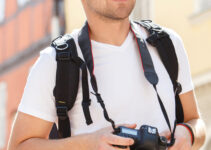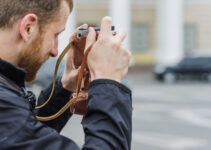Ever wondered how to carry your camera bag on a flight while keeping your gear safe and accessible?
Traveling with photography equipment requires careful planning to ensure your camera and accessories are protected from damage, theft, and mishandling.
Whether you’re a professional photographer or a hobbyist, knowing how to carry your camera bag on a flight is crucial.
This guide will help you navigate airline regulations, choose the right bag, and pack your equipment efficiently, so you can focus on capturing stunning images without the stress of worrying about your gear.
Here how to make a spy camera bag?
Can you carry camera bag on flight?
Yes, you can carry a camera bag on a flight, but it depends on the airline’s carry-on policies.
Most airlines allow you to bring a camera bag as part of your carry-on allowance, either as your main carry-on or as a personal item.
The size and weight of the bag should comply with the airline’s restrictions, typically fitting under the seat in front of you or in the overhead bin.
To protect your gear, use a well-padded camera bag, and consider packing batteries in your carry-on as they might be restricted in checked luggage.
It’s also a good idea to check the airline’s website for specific regulations, especially if you’re carrying extra equipment like tripods or drones, as these may require special handling.
Always carry important gear, like cameras and lenses, in your carry-on to avoid potential damage or loss during the flight.
Is it worth to carry camera bag on a flight
Carrying a camera bag on a flight is definitely worth it if you value your photography gear. Camera equipment is expensive and delicate, making it essential to keep it with you rather than checking it in.
Airlines can sometimes mishandle checked luggage, leading to potential damage or loss of your valuable gear.
By carrying your camera bag on board, you maintain control over your equipment and can ensure it stays safe.
A well-organized camera bag allows you to keep all your essential gear—camera body, lenses, batteries, memory cards—within easy reach. This is particularly useful if you plan to capture moments during your journey, such as stunning aerial shots or memorable moments at the airport.
Here, how to clean a tenba polyethelene camera bag?
Moreover, most airlines allow a camera bag as part of your carry-on allowance, making it convenient to bring along without incurring extra costs. In summary, carrying your camera bag on a flight is a practical choice that safeguards your gear and enhances your travel experience.
Things to know before carrying camera bag on a flight
Before carrying a camera bag on a flight, consider a few key factors to ensure a smooth experience.
First, check the airline’s carry-on size and weight restrictions, as your camera bag needs to comply with these limits. Most airlines allow a camera bag as a personal item, but it’s important to verify specific policies.
Next, organize your gear efficiently. Use padded dividers to protect your camera, lenses, and accessories from bumps during travel. Batteries should be packed in your carry-on as they are often restricted in checked luggage due to safety regulations.
Security checks are another consideration. Be prepared to remove your camera or electronic devices during screening. Keeping your bag organized will speed up this process.
Lastly, consider insuring your equipment before traveling.
While you can take steps to protect your gear, insurance offers an extra layer of security against potential loss or damage. These precautions ensure your camera equipment remains safe and accessible during your flight.
How to carry camera bag on flight?
Carrying a camera bag on a flight requires some planning to ensure both convenience and the safety of your gear.
First, choose a bag that meets airline carry-on size requirements and has adequate padding to protect your equipment.
A backpack-style camera bag is often more comfortable and easier to manage than a shoulder bag, especially when navigating through airports.
Here, how to make a bean bag for camera support?
Pack your camera, lenses, and other accessories in padded compartments, securing any loose items to prevent movement during the flight. Place batteries in your carry-on, as they are often restricted in checked baggage.
When going through security, be ready to remove your camera and electronics for screening. Keep your bag organized to make this process quick and hassle-free.
During the flight, store the camera bag under the seat in front of you or in the overhead bin to avoid potential damage from shifting luggage. This approach ensures your gear is safe and easily accessible throughout your journey.
7 Tips to carry camera bag on flight?
1. Choose the Right Camera Bag
Selecting the right camera bag is crucial for both protecting your gear and complying with airline regulations.
Opt for a bag that is well-padded and has customizable compartments to secure your camera, lenses, and accessories. Backpack-style camera bags are often preferred because they distribute weight evenly and are easier to carry through airports.
Ensure the bag meets airline carry-on size and weight restrictions, as oversized bags may need to be checked, risking damage to your equipment.
A bag with multiple access points and compartments can also help you organize your gear efficiently, making it easier to retrieve items quickly when needed.
Look for a bag with lockable zippers for added security, and consider water-resistant materials to protect against spills or wet weather during travel.
A well-chosen bag not only keeps your gear safe but also makes your travel experience more comfortable and hassle-free.
2. Pack Smartly
Smart packing is key to ensuring your camera gear stays safe during a flight. Use padded dividers inside your camera bag to keep your camera body, lenses, and accessories securely in place and protected from bumps and jolts.
Avoid overpacking the bag, as too much gear can lead to pressure on delicate equipment and make the bag difficult to manage.
Place heavier items like the camera body and larger lenses at the bottom of the bag to distribute weight evenly and prevent the bag from becoming top-heavy.
Smaller, more fragile items like filters or memory cards should be stored in dedicated pockets or pouches to avoid damage. Additionally, secure any loose items with Velcro straps or ties to prevent them from shifting during travel.
Packing smartly not only protects your gear but also helps you stay organized, making it easier to access what you need during the flight.
Here, what do you use as a bike camera bag?
3. Know Airline Regulations
Understanding airline regulations is essential before carrying a camera bag on a flight.
Each airline has specific size and weight limits for carry-on luggage, and your camera bag must comply with these restrictions to avoid having to check it.
Check the airline’s website or contact customer service to confirm their current policies, as they can vary by airline and even by route.
Some airlines may allow a camera bag as a personal item in addition to a carry-on, while others may require it to be your sole carry-on piece.
If you’re carrying extra gear like tripods or drones, be aware of any special handling requirements or additional fees that might apply.
Also, familiarize yourself with regulations regarding batteries, which must be packed in your carry-on due to safety concerns.
Knowing these rules in advance helps you avoid last-minute surprises at the airport and ensures a smoother travel experience.
4. Secure Batteries Properly
When flying with camera equipment, it’s important to secure your batteries properly to comply with airline regulations and ensure safety.
Lithium-ion batteries, commonly used in cameras, are restricted in checked luggage due to the risk of fire. Instead, they should be packed in your carry-on, where they are easily accessible and monitored.
To prevent short circuits, store batteries in their original packaging or use a dedicated battery case with terminal covers. If you don’t have a case, wrap the batteries individually in a non-conductive material like plastic.
Ensure that all batteries are fully charged, as some airlines or security agencies may ask you to power on your devices to verify they are functional.
Additionally, consider carrying a battery management pouch that organizes and protects your batteries while keeping them easily accessible.
Properly securing your batteries not only complies with safety regulations but also ensures you have the power you need for photography during your travels.
5. Prepare for Security Checks
Preparing for security checks can make your airport experience smoother and faster when carrying a camera bag.
Security personnel often require electronic devices, including cameras, to be removed from bags and placed in separate bins for X-ray screening.
To expedite this process, pack your camera and any large electronics in easily accessible compartments of your bag.
Keep smaller items like memory cards, cables, and filters organized in dedicated pockets to avoid delays during inspection.
Here, what does a camera and money bag emoji means on tinder?
Be aware that some security checkpoints may also require you to remove your camera from its case or even demonstrate that it functions properly.
Additionally, be prepared for your bag to be opened and inspected manually if the X-ray scan raises any concerns.
Packing your gear in a well-organized manner and being ready to quickly comply with security requirements helps you get through checks efficiently and reduces the risk of delays or issues at the airport.
6. Insure Your Gear
Insuring your camera gear before a flight is a wise precaution to protect against potential loss, theft, or damage.
While carrying your camera bag as a carry-on reduces the risk of damage from mishandling, accidents can still happen, and having insurance provides peace of mind.
Many home or renter’s insurance policies offer riders or additional coverage for high-value items like camera equipment, or you can purchase specialized photography insurance that covers both your gear and liability.
When insuring your equipment, make sure the policy covers international travel if you’re flying abroad, and check the claim process in case you need to use it.
Keep an updated inventory of your gear, including serial numbers, receipts, and photographs, to facilitate the claims process if necessary.
Insuring your gear ensures that you are financially protected in the event of an unfortunate incident, allowing you to focus on your photography without worry.
7. Store the Bag Safely Onboard
Storing your camera bag safely onboard is essential to protect your gear during the flight.
Ideally, place your bag under the seat in front of you where it is easily accessible and less likely to be disturbed by other passengers. If the bag is too large, store it in the overhead bin, but be cautious when placing it there.
Make sure it is securely positioned and not squeezed or stacked under heavy luggage, which could damage your equipment.
Avoid placing your bag near the bin’s edges, where items are more likely to shift during turbulence or when the bin is opened.
If possible, position the bag with the lens side facing up or sideways to minimize the risk of damage. Additionally, consider using a luggage strap to secure the bag if it has external buckles or loops.
Properly storing your camera bag onboard ensures that your gear remains protected throughout the flight.
5 Ways to carry camera bag on flight
1. Backpack-Style Camera Bag
A backpack-style camera bag is an excellent option for flights, offering balanced weight distribution and comfort during long walks through the airport.
It allows you to carry a significant amount of gear while keeping your hands free.
The padded shoulder straps and back support make it easier to manage, especially when navigating crowded spaces.
Backpacks usually fit under the seat or in the overhead bin, making them a convenient carry-on option.
Look for a bag with multiple compartments to keep your equipment organized and secure during travel.
2. Messenger Camera Bag
A messenger camera bag is a versatile option for those who prefer easy access to their gear.
Worn over the shoulder, it allows you to quickly reach your camera and accessories without removing the bag. This style is ideal for travelers who want to capture moments on the go.
However, be mindful of weight distribution, as carrying a heavy load on one shoulder for extended periods can cause discomfort.
Ensure the bag has adequate padding and secure compartments to protect your gear from bumps during the flight.
3. Roller Camera Bag
A roller camera bag combines the convenience of wheeled luggage with the protection of a camera bag.
Ideal for photographers traveling with heavy or bulky gear, it allows you to move through airports effortlessly without straining your back or shoulders.
Here, what size dry bag for camera?
These bags typically offer ample space and padded compartments to securely store your camera, lenses, and accessories.
Most roller camera bags are designed to fit in overhead bins, but it’s essential to check size restrictions with your airline.
This option is particularly useful for long trips or when you have other heavy carry-ons.
4. Dual-Purpose Travel Bag
A dual-purpose travel bag, which combines a camera bag with a standard carry-on, is ideal for travelers who want to minimize luggage.
These bags offer dedicated compartments for camera gear alongside space for personal items like clothing, toiletries, and a laptop. This design allows you to streamline your packing and reduce the number of bags you carry.
It’s a great option for short trips where you don’t need to bring a lot of gear but still want to keep your camera close at hand. Ensure the camera compartment is well-padded to protect your equipment.
5. Hard Shell Camera Case
A hard shell camera case provides maximum protection for your gear, particularly if you’re traveling with fragile or high-value equipment.
These cases are typically more rigid and durable than soft bags, offering excellent resistance to impact and rough handling.
While they are bulkier and may not fit under the seat, they are perfect for storing in the overhead bin. Some hard cases come with customizable foam inserts to keep your gear secure.
This option is best suited for photographers who prioritize gear safety and are willing to sacrifice a bit of convenience for added protection.
5 Methods to carry camera bag on flight
1. Use a Dedicated Camera Backpack
A dedicated camera backpack is one of the most practical methods for carrying your camera bag on a flight.
Designed specifically for photographers, these backpacks offer padded compartments and dividers to securely store your camera body, lenses, and accessories. The backpack style evenly distributes weight across your shoulders and back, making it more comfortable to carry for extended periods, especially when navigating busy airports.
Here, how to clean billingham canvas?
Many camera backpacks also have additional space for personal items, such as a laptop or travel essentials. They typically comply with airline carry-on size restrictions and fit easily under the seat or in the overhead bin.
Look for features like lockable zippers for added security and a weather-resistant exterior to protect your gear from the elements.
This method is ideal for photographers who need to carry a moderate amount of gear and want a balance between protection, comfort, and accessibility.
2. Carry a Roller Camera Bag
A roller camera bag is an excellent choice for photographers who travel with heavy or bulky equipment.
These bags combine the convenience of wheeled luggage with the specialized protection of a camera bag, allowing you to easily transport your gear through airports without straining your back or shoulders.
Roller bags usually feature padded compartments and customizable dividers to securely organize your camera, lenses, and accessories.
They often include additional pockets for personal items and travel essentials, making them versatile for longer trips.
Most roller camera bags are designed to fit within airline carry-on size limits and can be stored in the overhead bin.
When choosing a roller camera bag, look for durable wheels and a sturdy handle to ensure smooth maneuverability.
This method is particularly suitable for photographers who carry a significant amount of gear and prioritize ease of movement over the ability to access their equipment quickly.
3. Opt for a Messenger Camera Bag
A messenger camera bag offers quick access to your gear, making it a popular choice for photographers who want to capture moments on the go.
Worn over one shoulder, these bags allow you to easily reach your camera and lenses without removing the bag entirely.
Messenger bags typically feature padded compartments and dividers to protect your equipment from impacts and provide a comfortable carrying experience.
However, they may not distribute weight as evenly as a backpack, so it’s important to be mindful of the load to avoid shoulder strain.
Many messenger camera bags are compact enough to qualify as a personal item, in addition to your main carry-on, allowing you to bring more gear on board.
Here, how to put a tripod strap on a camera bag?
They are ideal for short trips or when you need to travel light, providing a balance between accessibility and protection.
This method is best for photographers who prioritize quick access and prefer a minimalist approach to carrying their equipment.
4. Use a Dual-Purpose Travel Bag
A dual-purpose travel bag combines the functionality of a camera bag with the practicality of a standard carry-on, making it an efficient option for travelers who want to minimize luggage.
These bags typically feature dedicated padded compartments for camera gear alongside space for personal items like clothing, toiletries, and a laptop. This design allows you to streamline your packing, reducing the number of bags you need to carry.
Dual-purpose bags often meet airline carry-on size requirements and can be stowed in the overhead bin, providing easy access to your gear throughout the flight.
This method is particularly useful for short trips where you need both your camera equipment and personal items but don’t want to carry multiple bags.
When choosing a dual-purpose bag, ensure that the camera compartment is well-padded to protect your gear, and that the bag is comfortable to carry for extended periods.
This method offers convenience, especially for photographers who want to travel light without sacrificing gear protection.
5. Carry a Hard Shell Camera Case
For photographers who prioritize maximum protection, a hard shell camera case is an ideal method for carrying gear on a flight.
These cases are made from durable, impact-resistant materials like polycarbonate or aluminum, providing superior protection against rough handling, drops, and other potential hazards during travel.
Hard shell cases typically feature customizable foam inserts that snugly fit your camera, lenses, and accessories, keeping them secure and preventing movement during transit.
Here, how to use camera bag dividers?
While these cases are bulkier and heavier than soft bags, they offer unmatched protection for high-value or fragile equipment. Most hard shell cases are designed to meet airline carry-on size regulations and can be stored in the overhead bin.
This method is particularly suitable for photographers traveling with expensive or delicate gear, such as professional-grade cameras and lenses, who are willing to sacrifice some convenience for the added security and peace of mind that a hard shell case provides.
5 Benefits to carry camera bag on flight
1. Enhanced Protection for Gear
Carrying your camera bag on a flight ensures that your valuable equipment is protected from potential damage.
Unlike checked luggage, which can be mishandled or subjected to rough conditions, keeping your camera gear with you in the cabin minimizes the risk of bumps, drops, or pressure.
A well-padded camera bag provides an additional layer of protection against impact, ensuring that your camera, lenses, and accessories remain safe during transit.
This peace of mind is particularly important for photographers who rely on their equipment for work or who carry expensive gear.
2. Immediate Access to Equipment
By carrying your camera bag on a flight, you have immediate access to your gear, allowing you to capture spontaneous moments during your journey.
Whether it’s a stunning aerial view from the plane window or an interesting scene at the airport, having your camera within reach enables you to take advantage of unexpected photo opportunities.
This convenience is especially beneficial for travel photographers or enthusiasts who want to document their entire travel experience without missing a beat.
3. Avoids Loss or Theft
Keeping your camera bag as a carry-on helps prevent loss or theft, which can occur with checked luggage.
Checked bags are handled by multiple parties, increasing the risk of them being misplaced or stolen.
By carrying your camera bag with you, you maintain control over its whereabouts throughout the journey.
Additionally, carrying your camera bag in the cabin reduces the chance of your gear being stolen, as it remains in your sight and within your reach at all times.
4. Compliance with Airline Regulations
Carrying your camera bag on board allows you to adhere to airline regulations, particularly concerning the transportation of lithium-ion batteries.
These batteries are commonly used in camera equipment and are often restricted in checked luggage due to fire hazards.
By carrying your camera bag in the cabin, you ensure that you comply with safety regulations and avoid potential issues at the airport.
Additionally, having your gear with you means you can respond quickly if security personnel request to inspect or power on your devices.
5. Reduces Travel Stress
Traveling with valuable camera gear can be stressful, especially if you’re worried about its safety.
Carrying your camera bag on a flight reduces this anxiety by ensuring that your equipment is always within your control. You won’t have to worry about it being damaged in the cargo hold or lost in transit.
This peace of mind allows you to relax and enjoy your journey, knowing that your gear is safe and ready for use whenever you need it.
Here, how to clean rust from vintage camera?
For photographers, this reduced stress can lead to a more enjoyable and productive travel experience.
How to carry camera bag on flight international?
Carrying a camera bag on an international flight requires careful planning to ensure your gear is safe and complies with airline regulations.
Start by selecting a well-padded, secure camera bag that fits within the carry-on size and weight limits of your airline.
Check the specific rules for the country you’re flying to, as they may have different regulations for batteries and electronics. Pack your gear efficiently, using padded dividers to protect your camera, lenses, and accessories.
Place any lithium-ion batteries in your carry-on, as they are often prohibited in checked luggage. Be prepared for security checks by organizing your bag so that you can easily remove your camera and electronics for screening.
Consider insuring your gear for international travel to protect against loss or damage. During the flight, store your camera bag in the overhead bin or under the seat in front of you to keep it safe and accessible.
How to carry camera bag on flight ryanair?
Carrying a camera bag on a Ryanair flight requires adherence to their specific baggage policies to avoid additional fees.
Ryanair typically allows one small cabin bag with maximum dimensions of 40cm x 20cm x 25cm for free.
Ensure your camera bag fits within these dimensions; if it doesn’t, consider using a backpack-style camera bag that can accommodate your gear while complying with the size limit.
If you have more equipment, consider purchasing a priority boarding option, which allows you to bring an additional larger cabin bag up to 55cm x 40cm x 20cm weighing up to 10kg.
Pack your gear efficiently, using padded dividers to protect your camera and lenses. Be prepared for security checks by keeping your camera and batteries accessible, as you may need to remove them for screening.
During the flight, store your camera bag under the seat in front of you or in the overhead compartment to ensure its safety.
Can we carry camera in international flight?
Yes, you can carry a camera on an international flight, but there are specific guidelines to follow.
Most airlines allow passengers to bring a camera as part of their carry-on luggage, which is recommended to ensure the safety of your gear. It’s essential to check the airline’s carry-on size and weight restrictions to ensure compliance.
When packing, use a well-padded camera bag to protect your equipment from bumps and jostles.
Additionally, ensure that lithium-ion batteries are stored in your carry-on, as they are often prohibited in checked luggage due to fire hazards.
During security checks, be prepared to remove your camera and electronic devices for screening, so keep them easily accessible in your bag.
If traveling to certain countries, check for specific regulations regarding photography equipment and customs requirements. Overall, carrying your camera on an international flight allows you to capture memorable moments while keeping your gear safe.
Can I take a camera on a plane in hand luggage?
Yes, you can take a camera on a plane in hand luggage, and it is generally advisable to do so for safety and convenience.
Most airlines allow passengers to carry cameras as part of their carry-on luggage, ensuring your valuable equipment is protected from damage or loss associated with checked baggage.
When packing, use a dedicated camera bag or padded case to keep your camera, lenses, and accessories secure during the flight.
Make sure your bag complies with the airline’s carry-on size and weight restrictions. If you have lithium-ion batteries, pack them in your hand luggage, as they are often restricted in checked bags due to fire risks.
During security screenings, be prepared to remove your camera and any other electronics for inspection.
Keeping your camera in hand luggage allows you to have easy access to it during your travels, ensuring you can capture spontaneous moments along the way.
Can I bring camera batteries on a plane?
Yes, you can bring camera batteries on a plane, but there are specific guidelines you must follow to ensure safety.
Lithium-ion batteries, commonly used in cameras, are permitted in carry-on luggage but are typically restricted in checked baggage due to fire hazards. Most airlines allow passengers to carry spare batteries, but it’s essential to pack them properly to prevent short circuits.
To ensure safety, store batteries in their original packaging or use a battery case designed for this purpose. If you do not have a case, wrap each battery in a non-conductive material, like plastic, to prevent contact with other metal objects.
Airlines usually have limits on the number of spare batteries you can carry, often allowing up to 100 watt-hours without special permission.
Always check the specific airline’s regulations regarding battery transportation before your flight, as rules may vary. Following these guidelines helps ensure a smooth travel experience while keeping your equipment powered.
Can we carry DSLR camera in flight?
Yes, you can carry a DSLR camera on a flight, and it is recommended to do so to ensure the safety of your valuable equipment.
Most airlines allow passengers to bring a DSLR camera as part of their carry-on luggage, which helps protect it from potential damage or loss associated with checked baggage.
When packing your DSLR, use a well-padded camera bag that complies with the airline’s size and weight restrictions for carry-on luggage.
Make sure to securely store your camera body, lenses, and accessories to prevent them from shifting during the flight.
Additionally, lithium-ion batteries should be packed in your carry-on, as they are typically restricted in checked luggage due to fire hazards.
During security checks, be prepared to remove your DSLR and any other electronic devices for inspection. Carrying your DSLR camera in the cabin allows you to capture spontaneous moments and ensures that your gear remains safe and accessible throughout your journey.
Can I carry my camera around my neck on a plane?
Yes, you can carry your camera around your neck on a plane, and many travelers do so for convenience and accessibility.
Wearing your camera this way keeps it within easy reach, allowing you to capture spontaneous moments while navigating the airport or boarding the flight. However, there are some considerations to keep in mind.
First, ensure that your camera is securely fastened with a reliable strap to prevent accidental drops.
It’s also important to be mindful of your surroundings, especially in crowded areas, as swinging or bumping into others can cause damage to your camera or inconvenience fellow passengers.
While wearing your camera, it’s wise to have a proper camera bag available for additional lenses and accessories, which may need to be stored in the overhead bin or under the seat.
Overall, carrying your camera around your neck is a practical option, provided you maintain awareness of your gear and your environment.
How to travel with camera gear on a plane?
Traveling with camera gear on a plane requires careful planning to ensure your equipment remains safe and accessible.
Start by selecting a high-quality, padded camera bag that complies with the airline’s carry-on size limits. Pack your camera, lenses, and accessories securely using dividers to prevent movement during transit.
Always carry lithium-ion batteries in your hand luggage, as they are typically restricted in checked baggage.
Organize your gear to facilitate quick access during security checks; you may need to remove your camera and electronics for inspection.
If traveling internationally, check the regulations for the countries you’re visiting, as they may have specific rules regarding photography equipment.
Consider insuring your gear for added peace of mind against loss or damage. During the flight, store your camera bag under the seat in front of you or in the overhead compartment to protect it from potential hazards. Following these steps ensures a smooth travel experience with your camera gear.
Related faq’s
Are DSLR cameras allowed in a carry-on bag in a domestic flight?
Yes, DSLR cameras are allowed in a carry-on bag on domestic flights. Most airlines permit passengers to bring a DSLR as part of their carry-on luggage, ensuring your valuable equipment is protected during travel.
To comply with size and weight restrictions, choose a well-padded camera bag that securely holds your camera, lenses, and accessories. Remember to pack lithium-ion batteries in your carry-on, as they are typically restricted in checked baggage.
During security checks, be prepared to remove your DSLR and any electronic devices for inspection. Carrying your DSLR in a carry-on bag provides easy access and peace of mind.
How do photographers take their equipment on a plane? With all the restrictions on ‘hand carry,’ I’m not sure I would trust checking in my camera kit.
Photographers typically take their equipment on a plane by using well-padded camera bags that comply with airline carry-on size restrictions.
They pack their gear securely, organizing cameras, lenses, and accessories to prevent movement during transit. Lithium-ion batteries are kept in carry-on luggage, as they’re often prohibited in checked bags.
To navigate security checks, photographers ensure their gear is easily accessible for inspection. Many opt for priority boarding to bring additional carry-on items.
This approach protects valuable equipment from damage or loss while providing quick access during the journey, offering peace of mind throughout the flight.
Can I carry a DSLR in my hand baggage on a domestic flight?
Yes, you can carry a DSLR in your hand baggage on a domestic flight. Most airlines allow passengers to bring their cameras as part of their carry-on luggage, ensuring the safety of your valuable equipment.
It’s advisable to use a well-padded camera bag that meets the airline’s size and weight restrictions. Pack your camera securely, along with any lenses and accessories, to prevent damage during transit.
Additionally, keep lithium-ion batteries in your carry-on, as they are typically restricted in checked luggage. Carrying your DSLR in hand baggage allows for easy access and peace of mind during your journey.
Is it safe to take your camera on an airplane without a hard case or hardware bag, and just use a lightweight or compact travel-sized monopod or tripod instead?
Taking your camera on an airplane without a hard case or padded bag is generally not recommended, as it increases the risk of damage during travel.
A lightweight or compact travel-sized monopod or tripod may provide some support, but it lacks the protective features needed to safeguard your camera from impacts or rough handling.
It’s best to use a padded camera bag designed for protection during transit. If you prefer a minimalist approach, ensure that your camera is securely padded and consider using a lens cap and protective filters.
Prioritizing protection helps ensure your equipment remains safe throughout the journey.
Conclusion
Carrying a camera bag on a flight requires careful consideration to ensure your equipment’s safety and accessibility.
Choose a well-padded bag that meets the airline’s carry-on size restrictions, and organize your camera, lenses, and accessories securely to prevent movement during transit.
Always pack lithium-ion batteries in your carry-on luggage and be prepared for security checks. During the flight, store your camera bag under the seat in front of you or in the overhead compartment.
By following these guidelines, you can protect your gear, enjoy peace of mind, and have quick access to your camera for capturing memorable moments during your travels.






